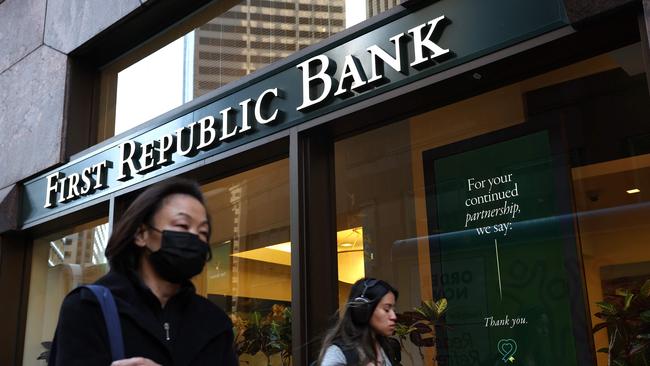Brace for rates volatility and its destabilising effect, says RBA assistant governor Brad Jones
A sustained period of higher interest rate volatility that could present ‘challenges’ for the stability of the financial system, RBA assistant governor Brad Jones says.

The Reserve Bank has warned of the potential for a sustained period of higher interest rate volatility that could present challenges for the stability of the financial system.
It’s one of several risks to financial stability identified by RBA assistant governor Brad Jones in his speech to the Australian Financial Industry Association conference on Tuesday.
“Much of the prior two decades saw long-term interest rate volatility either decline or languish at unusually subdued levels,” Dr Jones said.
“There are, however, a number of factors that, in the years ahead, could contribute to a regime shift characterised by structurally higher interest rate volatility.”
It comes amid intense debate about the longer-term outlook for inflation and interest rates amid structural forces such as deglobalisation, decarbonisation and the rising cost of extracting resources.
Higher interest rate volatility could lead investors to demand higher bond term premiums as compensation for the risk of interest rate fluctuations, underpinning bond yields at higher levels.
In his speech, Dr Jones said: “The great moderation (a period of decreased macroeconomic volatility that lasted from the mid-1980s until the financial crisis in 2007) is behind us.”
He said the global economy now appeared “more vulnerable to stagflationary supply shocks”, including from the “rewiring of globalisation, geopolitical and political economy tensions, and energy shocks from climate change and related policies”.
This contrasts with recent decades, where developments on the supply side of the economy were typically favourable for growth and inflation and so dampened financial market volatility.
Dr Jones also warned of a “higher and more volatile bond term premium” after a relentless decline over the past three decades. That previously favourable period pushed interest rates down to record lows, underpinning sharemarket valuations and helping governments finance their budget deficits.
It reflected factors including less uncertainty over future inflation outcomes and real policy rates, as well as structural supply–demand imbalances in bonds that meant governments were able to issue debt with little or even negative term premia, factors that he said were “unlikely to continue”.
Another risk is that the suppression of volatility in key bond markets from foreign exchange reserve managers and domestic asset purchase programs by central banks “now seems behind us”.
In recent years, reserve managers have become net sellers of US Treasuries, and based on their current plans central banks will be reducing their domestic bond holdings for years to come.
That’s occurring against a backdrop where broker-dealers have reduced ability and willingness to bid for bonds during periods of heightened volatility.
A period of structurally higher interest rate volatility would “present challenges to financial system stability” from bank duration risk, the interaction of interest rate and credit risk, and the smooth function of global financial markets, according to Dr Jones. He notes that inadequate management of interest rate risk was an important contributor to the US banking stresses in March.
At the time, Silicon Valley Bank lost 30 per cent of its deposit base in a matter of hours. It was poised to lose another 50 per cent the next day before regulators stepped in. The run on Silicon Valley Bank unleashed a wave of deposit runs that ultimately led to the failure of four regional US banks. The contagion spread to Europe, precipitating the collapse of Credit Suisse.
Dr Jones also warned of the interaction of interest rate and credit risk. “Over much of the past few decades, growth in incomes consistently exceeded the level of interest rates,” he said. “This dampened credit risks for lenders, but debt servicing among borrowers with high debt levels will be more challenging – and credit risks will increase as a result – in an environment where interest rates periodically exceed the growth in incomes.
“It also remains to be seen how market functioning could be affected in a regime of higher inflation and interest rate volatility, including where open-end fixed-income funds encounter liquidity stress, margining is more tightly enforced than in the past, and broker-dealers are unable or unwilling to supply liquidity.”
He notes the post-GFC era of exceptionally low interest rate volatility gave rise to a new generation of investment business models and strategies. These include strategies that involve the pro-cyclical leveraging up of bond positions when volatility dips and assume a negative correlation between bond and equity returns, as tends to occur in low and stable inflation regimes.
Other threats to the stability of the financial system that could come from the system itself include the potential for extremely rapid runs on bank deposits in the digital age and systemic risks arising from financial entities that individually aren’t systemically important.
Both were evident in the US regional banking crisis in March. Dr Jones says any bank would struggle to survive a run of the scale that hit Silicon Valley Bank. It was far beyond the provisioning required under Basel III, and more severe than the fastest runs experienced during the GFC.
Australia didn’t experience the types of stresses observed elsewhere as there wasn’t the same level of concentration risk or uninsured deposits in the deposit bases of key Australian banks, and our liquidity and capital requirements are more onerous.
“That said, there’s no sense of complacency … APRA will soon be consulting on options for strengthening liquidity and interest rate risk management requirements,” Dr Jones said.




To join the conversation, please log in. Don't have an account? Register
Join the conversation, you are commenting as Logout